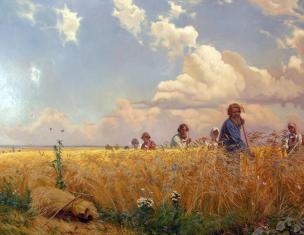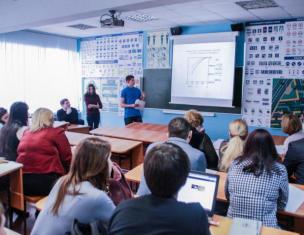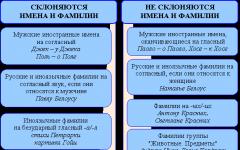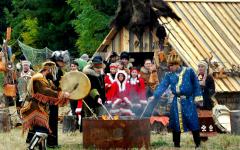Appearance in the scientific community in the middle of the 19th century cell theory, the authors of which were Schleiden and Schwann, became a real revolution in the development of all areas of biology without exception.
Another creator of cell theory, R. Virchow, is known for this aphorism: “Schwann stood on the shoulders of Schleiden.” The great Russian physiologist Ivan Pavlov, whose name is known to everyone, compared science to a construction site, where everything is interconnected and everything has its own preceding events. The “construction” of the cell theory is shared with the official authors by all predecessor scientists. On whose shoulders did they stand?
Start
The creation of the cell theory began about 350 years ago. The famous English scientist Robert Hooke invented a device in 1665, which he called a microscope. The toy interested him so much that he looked at everything that came to hand. The result of his passion was the book “Micrography”. Hooke wrote it, after which he began to enthusiastically engage in completely different research, and completely forgot about his microscope.
But it was the entry in his book No. 18 (he described the cells of an ordinary cork and called them cells) that glorified him as the discoverer of the cellular structure of all living things.
Robert Hooke abandoned his passion for the microscope, but it was picked up by world-famous scientists - Marcello Malpighi, Antonie van Leeuwenhoek, Caspar Friedrich Wolf, Jan Evangelista Purkinje, Robert Brown and others.

An improved model of the microscope allows the Frenchman Charles-François Brissot de Mirbel to conclude that all plants are formed from specialized cells united in tissues. And Jean Baptiste Lamarck transfers the idea of tissue structure to organisms of animal origin.
Matthias Schleiden
Matthias Jakob Schleiden (1804-1881), at the age of twenty-six, delighted his family by giving up his promising law practice and going to study at the medical faculty of the same Gettin University, where he received his education as a lawyer.
He did this for good reason - at the age of 35, Matthias Schleiden became a professor at the University of Jena, studying botany and plant physiology. Its goal is to find out how new cells are formed. In his works, he correctly identified the primacy of the nucleus in the formation of new cells, but was mistaken about the mechanisms of the process and the lack of similarity between plant and animal cells.
After five years of work, he writes an article entitled “On the Question of Plants,” proving cellular structure all parts of plants. The reviewer of the article, by the way, was the physiologist Johann Muller, whose assistant at that time was the future author of the cell theory T. Schwann.

Theodor Schwann
Schwann (1810-1882) dreamed of becoming a priest since childhood. He went to the University of Bonn to study as a philosopher, choosing this specialization as closer to his future career as a clergyman.
But youthful interest in natural sciences won out. Theodor Schwann graduated from the university Faculty of Medicine. For only five years he worked as an assistant to the physiologist I. Muller, but over the years he made so many discoveries that would be enough for several scientists. Suffice it to say that he discovered pepsin in gastric juice, and a specific fiber sheath in nerve endings. The novice researcher rediscovered yeast fungi and proved their involvement in fermentation processes.

Friends and associates
The scientific world of Germany at that time could not help but introduce future comrades. Both recalled meeting over lunch in a small restaurant in 1838. Schleiden and Schwann casually discussed current affairs. Schleiden talked about the presence of nuclei in plant cells and his way of viewing the cells using microscopic equipment.
This message turned the lives of both of them upside down - Schleiden and Schwann became friends and communicated a lot. After only a year of persistent study of animal cells, the work “Microscopic studies on the correspondence in the structure and growth of animals and plants” (1839) appeared. Theodor Schwann was able to see similarities in the structure and development of elementary units of animal and plant origin. And the main conclusion is that life is in a cage!

It was this postulate that entered biology as the cell theory of Schleiden and Schwann.
Revolution in biology
Like the foundation of the building, the discovery of the cell theory of Schleiden and Schwann launched a chain reaction of discoveries. Histology, cytology, pathological anatomy, physiology, biochemistry, embryology, evolutionary studies - all sciences began to actively develop, discovering new mechanisms of interaction in a living system. The German, like Schleiden and Schwann, the founder of pathanatomy Rudolf Virchow in 1858 supplemented the theory with the proposition “Every cell is a cell” (in Latin - Omnis cellula e cellula).
And the Russian I. Chistyakov (1874) and the Pole E. Strazburger (1875) discovered mitotic (vegetative, not sexual) cell division.
From all these discoveries, like bricks, the cellular theory of Schwann and Schleiden is built, the main postulates of which remain unchanged today.

Modern cell theory
Although in the one hundred and eighty years since Schleiden and Schwann formulated their postulates, experimental and theoretical knowledge has been obtained that has significantly expanded the boundaries of knowledge about the cell, the main provisions of the theory are almost the same and are briefly as follows:
- The unit of all living things is the cell - self-renewing, self-regulating and self-reproducing (the thesis of the unity of origin of all living organisms).
- All organisms on the planet have a similar cell structure, chemical composition and life processes (the thesis of homology, the unity of origin of all life on the planet).
- A cell is a system of biopolymers capable of reproducing what is like from what is not like itself (the thesis of the main property of life as a determining factor).
- Self-reproduction of cells is carried out by dividing the mother (thesis of heredity and continuity).
- Multicellular organisms are formed from specialized cells that form tissues, organs, and systems that are in close interconnection and mutual regulation (the thesis of an organism as a system with close intercellular, humoral, and nervous relationships).
- Cells are morphologically and functionally diverse and acquire specialization in multicellular organisms as a result of differentiation (thesis about totipotency, about the genetic equivalence of cells of a multicellular system).
End of "construction"
Years have passed, and in the arsenal of biologists there appeared electron microscope, researchers studied in detail the mitosis and meiosis of cells, the structure and role of organelles, the biochemistry of the cell, and even deciphered the DNA molecule. German scientists Schleiden and Schwann, together with their theory, became the support and foundation for subsequent discoveries. But we can definitely say that the system of knowledge about the cell is not yet complete. And every new discovery, brick by brick, advances humanity towards understanding the organization of all life on our planet.
Theodor Schwann's report will briefly tell you about the German biologist and founder of cell theory. A short biography of Theodor Schwann will tell you where Theodor Schwann lived and what he was like.
Theodor Schwann short biography
Theodor Schwann (years of life 1810-1882) was born in the city of Neuss. In 1833 he graduated from the University of Bonn. And after studying in Würzburg and Cologne in 1834-1838, he began working as an assistant to Johann Muller, a famous physiologist. Theodore was hardworking and purposeful, sometimes surprising even the wisest researchers. In just 5 years, he managed to make so many discoveries that other scientists would have spent their whole lives on. Scientist biologist Theodor Schwann was involved in various studies. While studying the physiology of digestion, he discovered special substance in gastric juice. It promoted the digestion of food. The scientist named this substance pepsin. Schwann made this grand discovery at the age of 26. Another year later, the researcher rediscovered yeast and the secret of fermentation. When Theodor Schwann examined yeast under a microscope, he established the following: yeast are living organisms. He brought the fermented liquid to a high temperature, and then the fermentation process stopped, and the fungi converted the sugar into alcohol. At the same time, carbon dioxide was released. This was pure nonsense.
In October 1838, Schwann met M. Schleiden, with whom they became friends and also became interested in the idea of cellular structure. They exchanged their thoughts regarding the difference in the structure of plant and animal cells. As a result, in just a year, the scientist completed a titanic work - “Microscopic Research” (1839). main idea books - life is concentrated in cells. This position of the researcher entered biology under the name Schleiden-Schwann cell theory. Theodor Schwann believed that new cells are formed by neoplasm from primary noncellular substance. However, his assumption would later be refuted by Rudolf Virchow, a German scientist.
In 1839, he received the position of professor of anatomy at the University of the Belgian city of Louvain. In 1841, the researcher became a member of the Academy of Sciences in Brussels. Later, the scientist moved to Liege and from 1858 began to head the department of physiology. Subsequently, Schwann only worked teaching activities. In 1879 he was admitted to membership French Academy Sciences and the Royal Society of London.
Theodor Schwann interesting facts
Schwann is often called the founder of modern histology.
Schwann's father was a jeweler and later worked in a printing house.
Only at the age of 69, three years before his death, did he leave work and research. In subsequent years, Schwann showed interest in theological problems.
Schwann established the basic principle of embryology by noting that the egg is a single cell that eventually develops into a complete organism.
Theodor Schwann was very a simple person, who remained aloof from the scientific controversies and petty rivalries that occur in the scientific fraternity. He was very loved and respected by his students. He has never been married.
We hope that the message about Theodor Schwann helped you prepare for the lesson and you learned a lot useful information about the life of the great German biologist. A short story You can add information about Theodor Schwann using the comment form below.
Theodor Schwann(Schann) - an outstanding German anatomist, physiologist and histologist (1810-1882), from 1829 to 1834 he studied medicine and natural Sciences in Bonn, Würzburg and Berlin, where he received the degree of doctor and doctor of medicine for the dissertation "De necessitate aeris atmosphaerici ad evolutionemn polli in ovo iucubato". In 1834 he was appointed assistant at the Anatomical Museum in Berlin, in 1839 he was invited as a professor of anatomy in Louvain, in 1848 as a professor of general and special anatomy in Lüttich, where in 1858 he occupied the department of physiology and comparative anatomy. In 1878 he retired. Schwann, while still a student, attracted the attention of his teacher, Johannes Müller, who took care of his appointment to Berlin, where Schwann participated in his teacher's microscopic research. First scientific works Schwann deals with issues of physiological chemistry, mainly artificial digestion, and he was the first to prove that the active factor in digestion is not the mucus secreted by the gastric mucosa, but a hitherto unknown substance - pepsin; at the same time, he was the first to find an analogy between the processes of digestion and alcoholic fermentation. Then Schwann could not decide to add to these two processes the process of decay, which he considered in the spirit of the time from the point of view of vitalism; only later did he refute the possibility of arbitrary processes in nature, which paved the way for modern views in the field of biology. Having experimentally proved the organic nature of the enzymes of putrefaction and fermentation (discovered at the same time by the Frenchman Latour), Schwann completely devoted himself to research in the field of histology, which created his worldwide fame. Before moving on to these works, it is also worth mentioning Schwann's discovery of the law of muscle contraction, showing that the strength of a muscle increases in the same proportion as the contraction of a muscle decreases. Of Schwann's histological works, his studies of the finest structure of blood vessels are most noteworthy, and Schwann experimentally proved the contractility of arteries, striated muscle fibers, regeneration and termination of nerve fibers, etc.; already these works showed Schwann’s great ability to solve the most complex questions on the finest structure of tissue elements, which was so brilliantly revealed with the appearance of his major work: “Mikroskopische Untersuchungen uber die Uebereinstimmung in der Structur und dem Wachsthum der Thiere und Pflanzen” (B., 1839, 4 tab.). In this work, Schwann proved the analogy between animal cells and plant cells and for the first time expressed the idea that all tissues and organs of animals consist of cells and come from them; so we can safely call Schwann the initiator of modern morphology. With these studies, which formed the basis of this work, Schwann managed to make whole line discoveries in the field of histology, such as the composition of the nail from plates, oblong nuclei in smooth muscle fibers, the composition of the structureless membrane of nerve fibers, named after him “Schwann's membrane”, from the membranes of individual cells, etc. All of these studies were carried out by Schwann in the first five years of his scientific activity (from 1834 to 1839); a professorship in a foreign country, in a language with which Schwann was little familiar, and disgust from the controversy that arose regarding his teachings, mainly in German scientific journals, forced him to devote his activities almost entirely to teaching. Schwann's main works, in addition to the above, are the following: "Versuche uber die kunstliche Verdauung des geronnenen Eiweissos" (together with J. Muller "Muller's Archiv", 1836); "Ueber das Wesen des Verdauungsprocesses" (ibid.); "Beitrage zur Anatomit der Nervenfaser" (ibid); "Anatomic du corps humain" (Brussels, 1855); "Versuche um auszumitteln, ob die Galle im Organismus eine fur das Leben wesentliche Rolle spielt" ("Muller"s Arch.", 1844) and others. In addition, Theodor Schwann wrote some chapters for J. Müller’s physiology textbook.
He did an invaluable job, because he was the author of the cell theory, it was this scientist who discovered pepsin.
Theodor Schwann's contributions to biology
Theodor Schwann(years of life 1810-1882) - German physiologist, biologist and founder of cell theory. He graduated from a Jesuit college in Cologne, then studied medicine and natural sciences in Würzburg, Bonn and Berlin. Until 1839, the scientist worked as an assistant physiologist with Müller in Berlin. Then hard work began in the field of science. The achievements of Theodor Schwann gave impetus to the development of new directions in biology. In 1839–1848 he became a professor of comparative anatomy and physiology at the University of Louvain. In the period 1848–1878 he served as a professor at the University of Liège. But we will talk about what contribution Theodor Schwann made to biology below.
Theodor Schwann's contribution to the development of biology
Theodor Schwann's discoveries in histology amazing. By studying the processes of fermentation and decay, he proved that they cause the appearance of lower fungi. In 1836 Theodor Schwann discovered pepsin, establishing that it is a necessary enzyme for protein digestion. He was interested in the possibility of the spontaneous generation of life, and for this purpose he conducted many experiments.
The scientist established the cellular structure of the walls of blood vessels, the dorsal chord, cartilage and muscles.
In 1838, a researcher described a peculiar thin sheath that surrounds peripheral nerve fibers. Subsequently, it was named after him - the Schwann membrane.
Theodor Schwann's contributions to science is that he in 1839 proved the cellular theory of the structure of organisms. The basis of this theory is the following premises:
- The cell is the basis of the structures of all organisms.
- Both animals and plants have a unity of structure.
- An organism is the sum of the cells that formed it.
- A cell is an elementary biological unit.
- The formation of new cells is a principle of development and organic growth in plants and animals.
After the discovery of cell theory (the most important thing that Theodor Schwann did for biology), the following became clear: after growth, the fruit membranes form folds. This occurs by slowly increasing the number of cells arranged in a specific pattern. The membrane also contains separate germ cells - sperm and egg, after the union of which new cells and an embryo appear.








